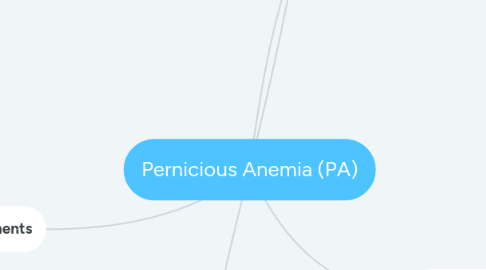
1. Treatments
1.1. Replacement of Vitamin B-12
1.1.1. Injections can be given weekly until stable, followed by monthly for life long treatment is needed
1.1.2. Can be given orally but requires higher doses for better absorption
1.2. No Cure for PA, requires lifelong treatment of Vitamin B-12
2. Diagnostic tests
2.1. Blood tests
2.1.1. CBC
2.1.2. Iron panels, serum folate,
2.2. Bone marrow aspiration
2.3. Serologic studies
2.3.1. Evaluate methylmalonic acid and homocysteine levels
2.4. Physical exam and assessment
2.5. Gastric biopsy
3. Pathophysiologic etiology
3.1. An autoimmune disease in which antibodies attack gastric cells resulting in impaired production of intrinsic factor (IF)
3.1.1. 1. IF is critical for absorption of Vitamin B-12 and for nuclear maturation & DNA synthesis
3.1.2. 2. IF is secreted by gastric parietal cells and complexes with dietary vitamin B-12 in small intestine
3.1.3. 3. The B12-IF complex binds to cell surface receptors in the ileum and transports across intestinal mucosa
3.2. Deficiency in IF secretion (Autoimmune)
3.2.1. Congenitial
3.2.1.1. affects 20-30% of persons if PA runs in family, especially first-degree relatives
3.2.1.2. autosomal recessive inheritance pattern
3.2.2. Inflammation
3.2.2.1. Type A chronic gastritis
3.2.2.1.1. 1. autoantibodies attack gastric H+-K+ ATPAse, a major proteins constituent of parietal cell membranes
3.2.2.1.2. 2. Gastric submucosa then becomes infiltrated with inflammatory cells (CD4 lymphocytes)
3.2.2.1.3. 3. causing gastric mucosal atrophy, in which gastric parietal cells are destroyed results in deficiency of IF and affects Vitamin B-12 absorption
3.2.3. Infection
3.2.3.1. Past infection w/ Helicobactor pylori is rare in PA
3.2.3.1.1. 1.Genetically prone persons may possess circulating antibodies against H.Pylori, which mimic parietal cell H+-K+ ATPase
3.2.3.1.2. 2. Resulting in production of antibody that binds and damages parietal cell
3.2.3.1.3. 3. thus, diminishing production of IF and affecting Vitamin B-12 absorption
4. Causative/risk factors
4.1. Family history of PA
4.2. Complete or partial gastrectomy- since the stomach makes intrinsic factors
4.3. Proton-Pump inhibitors (PPI)
4.3.1. may decrease Vitamin- B12 absorption
4.4. Type A chronic gastritis that may induced by environmental factors
4.4.1. Excessive alcohol intake
4.4.2. Smoking
4.4.3. hot tea ingestions
4.5. Autoimmune diseases of endocrine organs
4.5.1. Addison's dease
4.5.2. Type I Diabetes
4.5.3. Thyroiditis
4.5.4. Graves disease
4.5.5. Myasthenia gravis
5. Clinical manifestations
5.1. Slow onsets, early symptoms are vague and nonspecific
5.1.1. mood swings and infections
5.1.2. gastrointestinal, cadiac and kidney ailments
5.2. Anemic symptoms, Hgb 7-8g/dL
5.2.1. paresthesias of feet/fingers
5.2.2. loss of appetite, weight loss
5.2.3. sore and beefy red tongue
5.2.4. weakness/difficulty walking
5.2.5. feeling fatigue
5.3. Neurologic manifestations due to nerve demyelination may produce neuronal death
5.3.1. Spinal cord
5.3.1.1. loss of position and vibration sense, ataxia, and spasticity
5.3.2. Cerebrum
5.3.2.1. affective disorders (deressive types)
